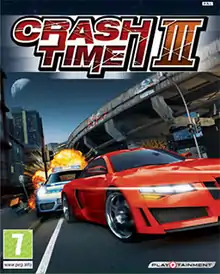Crash Time III
Alarm für Cobra 11: Highway Nights (also known as Crash Time III) is a racing video game developed by Synetic Games and published by RTL Playtainment. It is the third game adapted from the Alarm für Cobra 11 – Die Autobahnpolizei television series. The game was launched on November 27, 2009 for Xbox 360 and PC.
| Crash Time III | |
|---|---|
 | |
| Developer(s) | Synetic |
| Publisher(s) | |
| Engine | Unreal Engine 3 |
| Platform(s) | Microsoft Windows, Xbox 360 |
| Release | November 27, 2009 |
| Genre(s) | Racing |
Gameplay
The story is about Semir Gerkhan and Ben Jager (the duo from the previous game, Burning Wheels) who are assigned to infiltrate terrorist activity in the city and the Autobahn. The vehicles are fictitious, but resemble some famous cars. All of the cars have a generic C11 emblem (and/or the word Cobra) and a numberplate which starts with the initials SY, representing Synetic Games as the creator. Usually, the cars comes in 3 types, and the third type of the car is usually the tuned-up version of the car itself. The game consists of more than 70 missions, an area of 32 square kilometers (the city itself is loosely based on the city of Berlin) with more than 200 kilometers of city streets and Autobahn, 47 vehicles to choose from, Story Mode with dense story atmosphere, a dynamic in-car pathfinder function, and a typical ambiance of the series, with explosive crashes and high speed chases.
Objectives
Players not only have to complete tasks, but they have to do it as successfully as possible. The missions are rated up to five stars. The player loses a star if their tries, shots, tasks, or time does not stay within certain limits. Not only do the stars affect gameplay, but they also affect the player's overall rating as well; if they complete their missions without receiving any stars (or with a low quantity of stars), their rating will be affected negatively.
Suspects
There are a few things the player can do with suspects when they drive up to them on patrol, but in the missions, the player has to do a specific task with the suspect. The suspect vehicles use the path-finder system as well, so the path they use is not the same.
- Pursuit; Chase down the suspect. The player arrests him by either shooting his car, totaling it, or using the PIT maneuver (hitting the back-end at the side to put the suspect into a spin.) and stopping in front of him. For some specific missions, the player can use the drone to destroy the suspect vehicle.
- Shadowing; Keeping a distance from the suspect. They must not get too close, nor drive too far. The player should not make too much noise, either (ex. blaring their horn or crashing into too many traffic cars or obstacles). They should not turn on the police lights and the siren, either. Also, the player has to make sure that they do not bump the suspect, as that can be a dead giveaway. If the player waits a while as they're shadowing the suspect, the meter on the top left corner decreases in the level where the suspect notices the player.
- Race; If this happens during patrol, the player has to drive to a specific place and stop there before the suspect does.
Graphics and effects
While the traffic vehicles are mostly low in quality, they more than make up for that when it comes to the explosions. If the player crashes into a car at a speed higher than 100 km/h (62 mph), the traffic car that gets hit explodes, and when the cars explode near more vehicles, there is a chain of explosions. The cars the player drives (ranging from Semir's signature BMW 330d E90 to the classic Mercedes C350 W204 driven by Ben, along with the slow, yet powerful and resistant Rosenbauer Panther and the precise-handling, high-speed, and very powerful Formula C11 Racer) are very good in quality, and while Synetic's crash physics can sometimes become non-realistic in some situations, the scratches on the cars and shattered glass make up for that, giving the game more realism. In addition, the models of traffic cars and the cars the player drives are all sharing a same type of 3D model file format (Synetic style *.mox files for 3D model and *.mtl with a same name for corresponding materials and listing required texture files that are coded in a tga-like format, compressed ptx). All of these makes it possible to exchange the files to enhance the quality of traffic cars using other models from the game itself.
